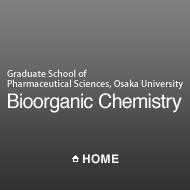
Research focus
In the bioorganic chemistry field, we base our research on nucleic acid chemistry with the aim of using nucleic acids to develop drugs.
Research in this area is pursued by two groups, one based on chemistry and another based on biology.
Research in this area is pursued by two groups, one based on chemistry and another based on biology.

Chemistry
The chemistry group aims to enhance the usefulness of nucleic acids as pharmaceutical products by modifying nucleic acids organochemically. Consisting of sugars, bases, and phosphates, nucleic acids may have interesting properties added to them when each part is modified on an organochemical level. In particular, we have discovered that artificial nucleic acids, which are bridged by modifying their sugars, have a high affinity with nucleic acids that have a complementary strand, and thus are extremely useful as nucleic acid drugs. We are also involved in applied research by utilizing these artificially added properties of nucleic acids.
 ●Sugar modification: antisense method, external stimuli
●Sugar modification: antisense method, external stimuli
●Base modification: antigene method, high-order structure control
●Phosphate modification: gene diagnosis
●Base modification: antigene method, high-order structure control
●Phosphate modification: gene diagnosis



Biology
Recent research has revealed that RNAs, which are generated by DNA transcription, are playing a diverse range of roles in vivo. We at the Division of Bioorganic Chemistry are working mainly on the antisense method with a view toward treating patients by controlling the functions of RNA that are related to diseases. The biology group is working on the creation of cutting-edge remedies through close collaboration with the chemistry group by, for example, using sugar-modified, bridged nucleic acids (BNAs) developed by the chemistry group to control the functions of RNA.
 ●Antisense method
●Antisense method
●Exon skipping
●Exon skipping

Bioorganic Chemistry, Graduate School of Pharmaceutical Sciences, Osaka University
1-6 Yamadaoka, Suita, Osaka 565-0871, Japan
TEL:+81-6-6879-8200 FAX:+81-6-6879-8204
obika@phs.osaka-u.ac.jp
1-6 Yamadaoka, Suita, Osaka 565-0871, Japan
TEL:+81-6-6879-8200 FAX:+81-6-6879-8204
obika@phs.osaka-u.ac.jp
